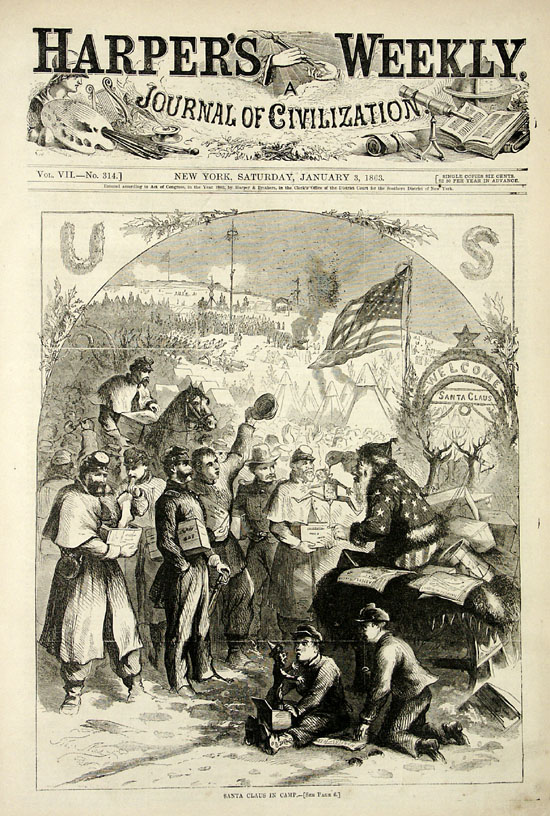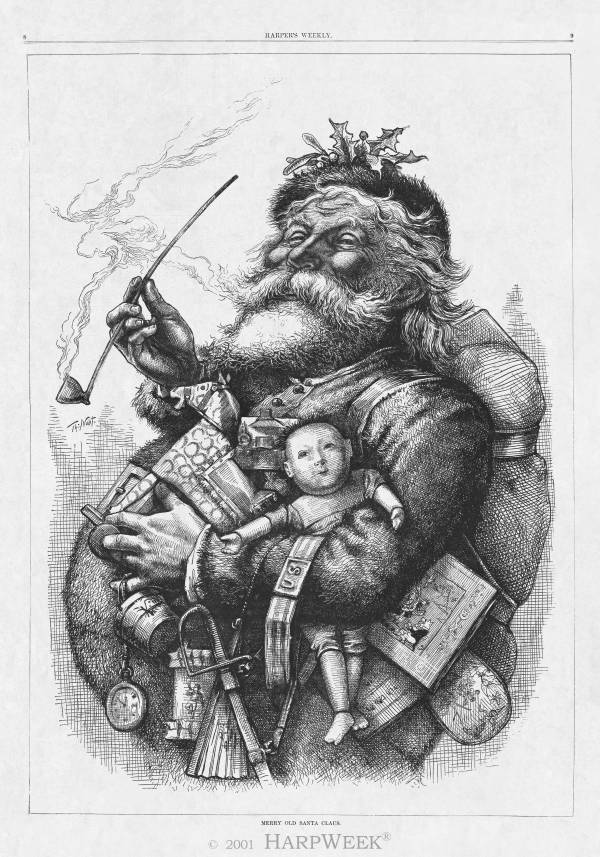Skip to comments.
Thomas Nast's "Pro War" Santa
Sweetness & Light ^
| December 24, 2005
| N/A
Posted on 12/24/2005 2:56:30 PM PST by Sam Hill
Since we have been on a Thomas Nast tear lately, it is only right and fitting that we should return to him at Christmas, as he is more or less the inventor of our Santa Claus.
Surprisingly, Nast's very first depiction of Santa Claus was a piece of political propaganda, done at the request of President Lincoln himself.
Lincoln thought a drawing showing Santa Claus in the Union camp would boost the North's morale and demoralize the South. It is reported to have accomplished both of these goals.
Shocking, isn't it? Our one party media's delicate sensibilities would not stand for such an outrage today. Unless of course it was done to further their agenda.
From the Son Of The South's Thomas Nast Collection:

Thomas Nast's Original Civil War "Santa Claus In Camp"
This is Thomas Nast's earliest published picture of Santa Claus. Nast is generally credited with creating our popular image of Santa. This illustration appeared in the January 3, 1863 edition of Harper's Weekly, and shows Santa Claus visiting a Civil War Camp. In the background, a sign can be seen that reads "Welcome Santa Claus."
The illustration shows Santa handing out gifts to Children and Soldiers. One soldier receives a new pair of socks, which would no doubt be one of the most wonderful things a soldier of the time could receive. Santa is pictured sitting on his sleigh, which is being pulled by reindeer. Santa is pictured with a long white beard, a furry hat, collar and belt. We can see that many of our modern perceptions of Santa Claus are demonstrated in the 140 year old print.
Perhaps most interesting about this print is the special gift in Santa's hand. Santa is holding a dancing puppet of none-other-than Jefferson Davis, President of the Confederate States of America. The likeness to Jefferson Davis is unmistakable. Even more interesting, Davis appears to have the string tied around his neck, so Santa appears to by Lynching Jefferson Davis!
And from the archives of Harper's Weekly:
While setting the national standard, Nast’s own depiction of Santa Claus changed over the years. He began his almost-annual contribution of Christmas illustrations when he joined the staff of Harper’s Weekly in 1862 during the Civil War. His first Santa (in the postdated January 3, 1863 issue) is a small elf distributing Christmas presents to Union soldiers in camp. Santa dangles by the neck a comical jumping jack identified in accompanying text as Jefferson Davis, the Confederate president. There was no doubt in Nast’s illustration whose side Santa favors in the war.
Although other artists of the period sketched Santa Claus, Nast stands apart from the rest for his role in creating and popularizing the modern image of the Christmas figure. He contributed 33 Christmas drawings to Harper’s Weekly from 1863 through 1886, and Santa is seen or referenced in all but one.
Nast’s full-page illustration of Santa Claus in 1881 [below] quickly attained status akin to an official portrait, and is still widely reproduced today. Before Nast, different regions, ethnic groups, and artists in the United States presented Santa Claus in various ways. A sketch in Harper’s Weekly from 1858 shows a beardless Santa whose sleigh is pulled by a turkey.
Nast was instrumental in standardizing and nationalizing the image of a jolly, kind, and portly Santa in a red, fur-trimmed suit delivering toys from his North Pole workshop.
TOPICS: Extended News; News/Current Events; Political Humor/Cartoons
KEYWORDS: abelincoln; dixie; nast; santaclaus; thomasnast
Navigation: use the links below to view more comments.
first previous 1-20, 21-31 last
To: Sam Hill
Why do you keep posting to me? You seem rather defensive.
To: steelcurtain
No, just rubbing your nose in it. In the Christmas spirit:
"Thomas Nast is best known for his Christmas drawings. His first appeared in Harper's Weekly for Christmas of 1862. His Christmas drawings mark the first appearance of Santa Claus as we know him today. Prior to this, Santa had passed through a series of stages beginning with a more religious-type figure.
The inspiration for how Nast's Santa should look came from Clement Moore's poem 'Twas a Night Before Christmas. Still lacking reading skills, he had his wife read to him while he prepared his drawings and engravings. On one occasion, Mrs. Nast read Clement Moore's poem to Thomas. That was all it took for inspiration.
The next 24 years saw Nast produce 76 Christmas engravings that were signed and published. Nast used Moore's poem to put it all together in visual form; a sleigh, reindeer, jolly old elf, filling the stockings hung by the chimney, and so forth.
In addition, Nast used his own imagination to expand upon the theme. He was the first to establish that Santa's home was in the North Pole. In this way, Santa didn't belong to any one country -- he became a citizen of the world. The concept of Santa having a workshop and elves to help him were also Nast's idea. Prior to his engravings, all children received gifts from Santa. Nast conceived the idea that bad children didn't get gifts from Santa. The custom of sending Santa a letter is also due to Thomas Nast. Although the custom of kissing under mistletoe was known in Europe prior to Nast's engravings, it was through his engravings in America that the custom caught on there.
Thomas Nast brought Christmas to a large audience through his engravings. The result of the impact that these drawings had on American's is astronomical. In Europe, Christmas was observed for centuries on December 6. By the late 1800's when Nast's Santa Claus gained popularity, Christmas Day was legally established as December 25 in all states and territories in the United States. In addition, an extended school vacation during this period became a custom. (A brief pause while all students write a thank you note to the Nast estate.)
From this seed, Christmas began the move to commercial and economic interests. Stores began including drawings of Santa (though not necessarily done by Nast) in their ads and tying it in with Christmas sales and promotions. Soon to follow was the custom of sending Christmas cards. Without Nast and his Christmas drawings he brought to the masses, it is hard to tell what Christmas and the customs that go with it would be like today." http://www.historybuff.com/library/refnast.html
22
posted on
12/24/2005 3:50:26 PM PST
by
Sam Hill
To: Sam Hill
...and the article referred to the NYT. So much for that research.
23
posted on
12/24/2005 3:52:04 PM PST
by
wizr
(Fear not death. Christ lives.)
To: Sam Hill
No, just rubbing your nose in it. In the Christmas spirit: How very mature of you.
To: Sam Hill; Jackknife
To: Sam Hill
One soldier receives a new pair of socks, which would no doubt be one of the most wonderful things a soldier of the time could receive.
The officer on his left looks a lot like Burnside, of Fredericksburg "fame" and sacked by Lincoln three weeks after this Harper's.
To: Bars4Bill
Could be, I guess. He's sure got the side-burns for it. (As do a couple others.)
27
posted on
12/24/2005 4:24:44 PM PST
by
Sam Hill
To: Sam Hill
When I was very young, (I'm 70), my uncle was a fireman in Morristown, NJ. In the station was a drawing of Santa by Nast, if memory is correct, the origenal. I believe Nast was a member of that station, and as far as I know, the picture is still there.
28
posted on
12/24/2005 6:20:18 PM PST
by
gunner03
(just another grunt)
To: Sam Hill
So nowadays could we have Santa Claus with Howard Dean on a leash?? :^) ooops, I guess that would be "mean-spirited"..........
29
posted on
12/26/2005 10:18:21 AM PST
by
Enchante
(Democrats: "We are ALL broken and worn out, our party & ideas, what else is new?")
To: Enchante
"So nowadays could we have Santa Claus with Howard Dean on a leash?"
I was trying to think of who would be the parallel to Jefferson Davis, and you're right -- Howard Dean is a very good candidate.
Of course he doesn't have one fraction of Jeff Davis' background or integrity.
And Jeff Davis might have been a "rebel" but he was no traitor -- like Dean is.
30
posted on
12/26/2005 10:52:01 AM PST
by
Sam Hill
To: Sam Hill
You're right, Jefferson Davis possessed a level of intellect and integrity that charlatans of the contemporary left like Dean cannot even imagine.
31
posted on
12/26/2005 4:06:32 PM PST
by
Enchante
(Democrats: "We are ALL broken and worn out, our party & ideas, what else is new?")
Navigation: use the links below to view more comments.
first previous 1-20, 21-31 last
Disclaimer:
Opinions posted on Free Republic are those of the individual
posters and do not necessarily represent the opinion of Free Republic or its
management. All materials posted herein are protected by copyright law and the
exemption for fair use of copyrighted works.
FreeRepublic.com is powered by software copyright 2000-2008 John Robinson

